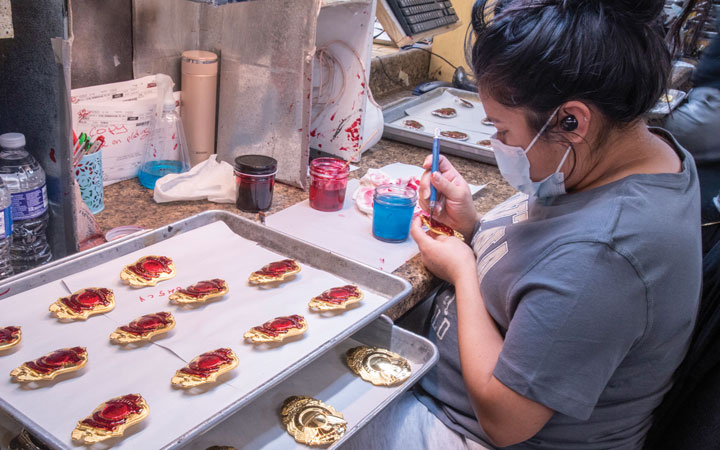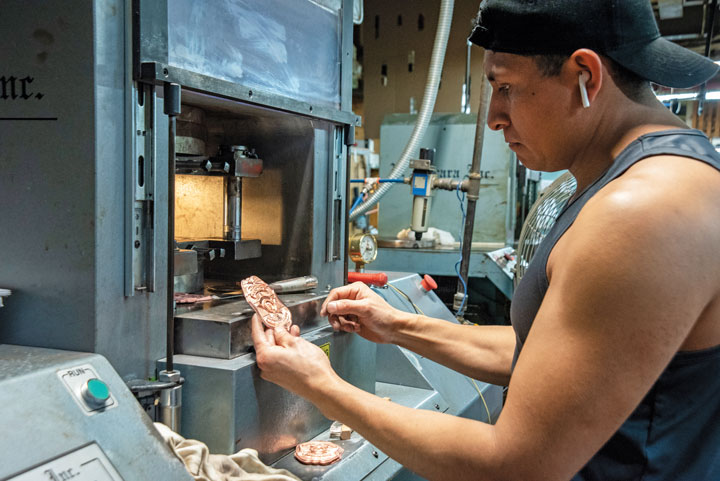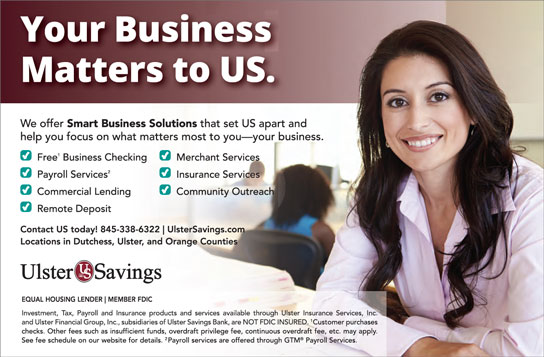ELEVATING THE BADGE

HV Mfg sat down with Lee Galperin, President of Smith & Warren, Inc. The White Plains company designs and manufactures custom badges for police and fire departments, security firms, the military, and other agencies.
We learned about the science (and art) of badge making, the integration of technology into that process, the vital role of quality and service in the business’s success, the challenges and responsibilities of leading a second-generation family business, and maintaining a positive company culture.
HV Mfg: Thank you for making the time to speak with us. Tell us about Smith & Warren.
LG: Thank you for thinking of me for this interview.
Smith & Warren designs and manufactures badges that are worn by public safety professionals. We have been doing it now for 99 years. When I talk about the business, I like to start with our mission statement because I think it really sums up who we are. At Smith & Warren, our mission is ‘to provide a positive buying experience for our customers and to produce the highest quality badges and insignia for departments and agencies across the world.’
We make badges for police departments, sheriff departments, fire/EMS departments, the federal government, the military, private security companies, and more. We make the official duty badges worn on the uniforms as well as the flat badges carried in the wallets/ID cases. In addition to the traditional duty badge, we also make commemorative badges and awareness badges. We make medals and nameplates, insignia pins, collar letters and pins, tie bars, and service award/commendation bars. All of them are made in the USA, in fact, they are all made right here in White Plains.

HV Mfg: I’m going to venture to guess that most of our readers have not given much thought to badge-making. Take us through the process – from design to delivery.
LG: I guess that’s probably true. It is a bit of a niche business, but I suspect most people will be familiar with the different processes we employ. Let’s start with the customer. Say your hometown police department is looking to design a new badge. They will reach out to us and together with one of our designers we will discuss design options. They may opt to start with a standard design. On our website, we have a program called “VisualBadge” that allows a user to select from over 1,500 badge design templates.
They can then design the entire badge on the screen with different lettering, metal finishes, attachments, and other options. If they want something truly unique we can work with them on a full custom design using our “BadgeStudio” program. With BadgeStudio, we can incorporate their town seal, landmarks, landscapes, core values, and other features that represent their department or community. Once a design is agreed on, our production team will lay out the steps needed to manufacture the product.
HV Mfg: Do those steps vary?
LG: They can, depending on what is featured in the design. All badges will start in the stamping department where the raw stamping is made in a 650-ton coining press. We have dies and tools for our standard designs, but for use BadgeStudio for full custom designs, and start by cutting the dies and tools. For that, we employ the use of 3D CAD, CNC milling, laser die-cutting, and wire EDM.
We have an incredibly talented team of digital 3D designers, die-cutters, tool-makers, and machinists on our team that make these badge designs come to life. All badges will then be individually engraved. We have over 125 rotary engraving machines operating daily. To staff this operation we provide in-house training for graphic layout and machining jobs.
After engraving the next step is referred to as “assembly”. Here is where our skilled handicraft artisans get involved. Each badge design will have some combination of soldering, enameling, and polishing. The colored enamel can be applied using paint, but the majority of Smith & Warren badges utilize an enamel method called Cloisonné Hard Enamel. This is a process by which glass is fused to metal. It is an ancient art that has mostly been lost, but our company continues to train people how to do it and is keeping the tradition alive. Glass has largely been replaced by epoxy resin in our industry, but we know glass is way better so we have committed ourselves to continuing to offer it.

One of the final stages of production is the metal finishing. We have a state-of-the-art electroplating facility that uses the latest equipment to finish badges with a uniformly thick and durable precious metal coating.
Once the metal finishing is complete each badge goes through a quality inspection and, once that is done, the badge is boxed to be shipped and delivered to the customer.
HV Mfg: Quality must be a major priority for you.
LG: The top priority. Badges pass through numerous rigorous quality control stations throughout production. Prior to shipping, each order is carefully inspected by hand for quality, accuracy, and completeness.
While this is the end of our process – our time with the badge – we like to remember that for many of our clients, receiving this badge is going to be one of the most important events of their lives. I know that can sound a bit dramatic but in many cases, the new badge means the start of a new career in public safety, new responsibilities, a promotion, or even an honorable retirement. Chances are the presentation of the badge is a special moment and we want that moment to be perfect.
It is something that I think makes our company special, the fact that our employees ‘elevate the badge’ they feel great pride and the responsibility that goes with making something very significant to the people who will wear what they made.
The industry standard was to manufacture badges in 4 to 6 weeks. My father decided in 1990 that he would make them in 2 weeks. The big players at the time scoffed at the idea, but he figured it out.
HV Mfg: We can see where that can be a powerful motivation for the right people. We will come back to that, but for now, talk about how you came into the business. You are second generation, correct?
LG: That is correct and there is a bit of a story, not only about my coming into the business but about how my parents acquired it. My father immigrated to this country from Romania in 1967. He came here with a degree in petroleum engineering but went on to get a master’s in mechanical engineering from Columbia University and eventually his Professional Engineering (PE) license. He worked for engineering firms, but by the late 1970s he knew he wanted to do something more entrepreneurial.
In 1982 he bought into an electroplating business, Electroplating Service, Inc. The business was successful until the late 1980s when manufacturers in the region started closing up facilities and moving them to lower-cost regions. Even though their quality and service were good, he saw the handwriting on the wall and started looking to diversify. He wanted something where he could still apply his engineering talents but also would be less likely to be threatened by offshore competition. He also wanted to make a complete product and not be a subcontractor.
In 1989 my father saw an advertisement in the New York Times for a small badge manufacturing company in NYC for sale. He and my mother decided to buy it. The company was very small, but he felt confident with his technical expertise and experience in metal finishing that it represented a great opportunity. That company was Smith & Warren.
He and my mother were running both businesses, but within a short time started to realize that the badge business had great potential. They started to put all their efforts behind it.

HV Mfg: Were you involved at all in any of this transition?
LG: Not really. I mean I was in high school and college during this time. Frankly, the business was very small and my parents did not really present it as an option. They wanted my sister and I to pursue professional careers.
HV Mfg: Where did you go to school?
LG: Lehigh. I graduated in 1997 with a degree in Finance and Accounting and took a job with Arthur Anderson in financial audit. Meanwhile, Smith & Warren was starting to do well and was steadily growing. The business was still small, but my parents were figuring out some things that would eventually become our competitive advantage. My opportunity to join the business came in 1999.
A competitor came up for sale. This business was about 2x our size and represented an opportunity for us to go from servicing primarily a regional market to a national market because they had a national network of dealers and a broader product line.
While working at Arthur Andersen I started to take an interest in the business and helped with some of the financial documents needed to complete the transaction. I wanted to join immediately after the acquisition in June 1999, but my parents encouraged me to remain in public accounting to get my CPA license. In January 2000, after getting the CPA license, I left public accounting and joined Smith & Warren with my parents. My sister joined us a year later.
Because a quality product and the buying experience are our priorities, each process, each step, and each person is critical to our success.
HV Mfg: And your parents stayed on?
LG: Yes. We all worked together for 12 years. My parents had great chemistry at work. My father had the vision and a relentless work ethic. He moved fast…really fast on his ideas. My mother was a great administrator. As fast as my father moved she was able to keep everything straight. Employees got paid, bills got paid, orders were processed and the lights stayed on.
The first few years I worked inside the factory learning the operations and improving my technical skills. After I got a handle on operations and with my father leading our manufacturing operations, I saw a big opportunity to develop our sales and marketing operations. While my father continued to build our manufacturing capabilities I spent a lot of time working on growing our dealer network and bringing in new business.
Eventually, I had to turn my attention back to operations as it became clear that this business had a big future and I would eventually need to lead it. We worked together until the end of 2012 when my parents sold the business to me and my sister.
HV Mfg: If your father built and improved the process side of things as a trained engineer, are you focused on the operations and financial side as a CPA and former consultant?
LG: Yes, that is fair to say for the 12 years we worked together. My father is an excellent engineer and has great business instincts. While not an expert in marketing, he understood what customers wanted. While the industry standard was to manufacture badges in 4 to 6 weeks my father decided in 1990 that he would make them in 2 weeks.
The big players at the time scoffed at the idea, but he figured it out. My father and I definitely think differently, but that was probably an advantage. We came to every project from a different angle. That probably allowed us to get them done even better.
HV Mfg: How did you cut manufacturing time in half? Did Technology play a role?
LG: A lot had to come together to cut manufacturing time in half, but our effective use of information technology launched us to the next level. Our business is very unique in that we manufacture a highly customized product in relatively high volume. We average about 40,000 SKUs in process at any one time – sometimes it gets as high as 70,000 SKUs. My father and I realized we needed to get a better handle on our operations to scale.
Our ERP system, known as VBadge, is completely customized and truly appreciated by our entire company. In 1992, my father had the idea of hiring a programmer and building customized software to manage orders and production. As the company grew so did the software and eventually, we decided to make it a full custom ERP and it has worked out well.
We have so many customers and dies and raw materials, that none of the off-the-shelf systems were ideal. Each felt like we were trying to fit our round peg into their square hole. VBadge gave us the ability to accurately move products through the factory faster without sacrificing quality because of enhanced operations management tools. Because we developed the ERP, we can adapt it to our evolving needs, and in 2023 we began work on the next version of VBadge.
HV Mfg: Let’s circle back to something you said earlier –“elevate the badge.” What do you mean by that? It sounds almost like a rallying cry.
LG: It’s more of a philosophy or a way to remind us of the importance of what we do for our customers and to keep our focus on quality and service. If our mission is to provide a positive buying experience and make the highest quality product, then prioritizing – or “elevating” – each and every badge keeps us focused on that mission.
HV Mfg: We walked through the factory not long ago and were impressed by the engagement of the people on the floor. From what we saw they clearly are committed to their tasks and understand how and where they are contributing to the finished product.
LG: I appreciate hearing that and I agree. I think we have a great group of people here. We have a little more than 150 team members now, most live near the plant right here in White Plains and every one of them is important. That is more than a cliché. As we discussed earlier, we have so many steps in our process and so many SKUs winding their way through the plant it means that everyone is dependent on someone else – and everyone is responsible to someone else – if we are to get the job done. And because a quality product and the buying experience are our priorities, each process, each step, and each person is critical to our success.
Having people working with us who understand that and who embrace that is what differentiates us from our competition.
I’ll tell you a quick story. A few years ago we had a new hire who did not show up to work one morning and didn’t call or touch base in any way. The next day he came in and I went to see him and I said: “Hey, we missed you yesterday, if you are sick or can’t get here give us a call.” He said something like: “Okay, I didn’t know, I figured I’m only paid when I work so it didn’t matter.”
I told him he did matter – I explained that – for one thing, we were worried about him – and for another thing his not being there left a hole in production. Other people had to cover, production schedules got disrupted and we might not have been able to deliver some products on time. He did not realize his value to the business and seemed to respond positively to the conversation. He was not just a number, he was part of a team and his contribution was valued.
I learned from that experience that I have to keep reminding people of where they fit in and the important role each of them plays at Smith & Warren. We are a team and when on the shop floor we need to operate at our very best.
HV Mfg: Describe your leadership style.
LG: I guess fundamentally it is to lead by example and to listen.
I believe it is important to be present and to work hard, which sets a good example. I think good leaders seek feedback and listen because people need to feel heard, and frankly some great things come from listening to the people touching the badges every day. I want to make sure our folks believe that they are part of something important – because they are.
With that said I also think it is important to be decisive without being stubborn.
HV Mfg: What are some of the challenges you see in the near future? What are some of the opportunities?
LG: I guess one challenge would be competition from low-cost offshore competitors. For the most part ‘Made in the USA’ is still important for our customers, however, that can change as the cost model changes.
We always need to look to be more efficient in making our products so we remain competitive. But efficiency can never come at the cost of quality because that is our highest priority. Our website, for example, has proved to be highly effective and efficient and the quality of the customer experience has only improved.
We are also always looking to acquire complementary businesses so we can grow and build economies of scale. Not aggressively looking, but over the years we have acquired some companies, including two in 2023, and we will continue to be open to acquisitions.
HV Mfg: Thank you for your time – we learned a lot and will never look at any badge quite the same way again.
LG: Thank you. I enjoyed speaking with you and I appreciate the work the Council of Industry does for manufacturers like us.






